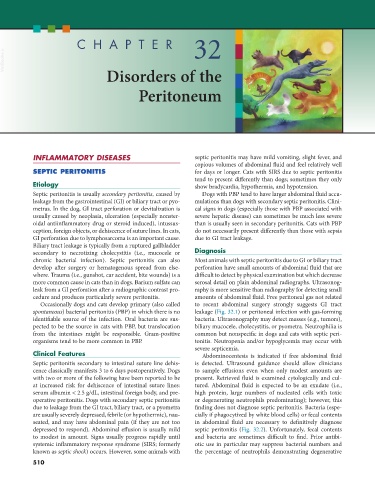Page 538 - Small Animal Internal Medicine, 6th Edition
P. 538
510 PART III Digestive System Disorders
CHAPTER 32
VetBooks.ir
Disorders of the
Peritoneum
INFLAMMATORY DISEASES septic peritonitis may have mild vomiting, slight fever, and
copious volumes of abdominal fluid and feel relatively well
SEPTIC PERITONITIS for days or longer. Cats with SIRS due to septic peritonitis
tend to present differently than dogs; sometimes they only
Etiology show bradycardia, hypothermia, and hypotension.
Septic peritonitis is usually secondary peritonitis, caused by Dogs with PBP tend to have larger abdominal fluid accu-
leakage from the gastrointestinal (GI) or biliary tract or pyo- mulations than dogs with secondary septic peritonitis. Clini-
metras. In the dog, GI tract perforation or devitalization is cal signs in dogs (especially those with PBP associated with
usually caused by neoplasia, ulceration (especially nonster- severe hepatic disease) can sometimes be much less severe
oidal antiinflammatory drug or steroid induced), intussus- than is usually seen in secondary peritonitis. Cats with PBP
ception, foreign objects, or dehiscence of suture lines. In cats, do not necessarily present differently than those with sepsis
GI perforation due to lymphosarcoma is an important cause. due to GI tract leakage.
Biliary tract leakage is typically from a ruptured gallbladder
secondary to necrotizing cholecystitis (i.e., mucocele or Diagnosis
chronic bacterial infection). Septic peritonitis can also Most animals with septic peritonitis due to GI or biliary tract
develop after surgery or hematogenous spread from else- perforation have small amounts of abdominal fluid that are
where. Trauma (i.e., gunshot, car accident, bite wounds) is a difficult to detect by physical examination but which decrease
more common cause in cats than in dogs. Barium sulfate can serosal detail on plain abdominal radiographs. Ultrasonog-
leak from a GI perforation after a radiographic contrast pro- raphy is more sensitive than radiography for detecting small
cedure and produces particularly severe peritonitis. amounts of abdominal fluid. Free peritoneal gas not related
Occasionally dogs and cats develop primary (also called to recent abdominal surgery strongly suggests GI tract
spontaneous) bacterial peritonitis (PBP) in which there is no leakage (Fig. 32.1) or peritoneal infection with gas-forming
identifiable source of the infection. Oral bacteria are sus- bacteria. Ultrasonography may detect masses (e.g., tumors),
pected to be the source in cats with PBP, but translocation biliary mucocele, cholecystitis, or pyometra. Neutrophilia is
from the intestines might be responsible. Gram-positive common but nonspecific in dogs and cats with septic peri-
organisms tend to be more common in PBP. tonitis. Neutropenia and/or hypoglycemia may occur with
severe septicemia.
Clinical Features Abdominocentesis is indicated if free abdominal fluid
Septic peritonitis secondary to intestinal suture line dehis- is detected. Ultrasound guidance should allow clinicians
cence classically manifests 3 to 6 days postoperatively. Dogs to sample effusions even when only modest amounts are
with two or more of the following have been reported to be present. Retrieved fluid is examined cytologically and cul-
at increased risk for dehiscence of intestinal suture lines: tured. Abdominal fluid is expected to be an exudate (i.e.,
serum albumin < 2.5 g/dL, intestinal foreign body, and pre- high protein, large numbers of nucleated cells with toxic
operative peritonitis. Dogs with secondary septic peritonitis or degenerating neutrophils predominating); however, this
due to leakage from the GI tract, biliary tract, or a pyometra finding does not diagnose septic peritonitis. Bacteria (espe-
are usually severely depressed, febrile (or hypothermic), nau- cially if phagocytized by white blood cells) or fecal contents
seated, and may have abdominal pain (if they are not too in abdominal fluid are necessary to definitively diagnose
depressed to respond). Abdominal effusion is usually mild septic peritonitis (Fig. 32.2). Unfortunately, fecal contents
to modest in amount. Signs usually progress rapidly until and bacteria are sometimes difficult to find. Prior antibi-
systemic inflammatory response syndrome (SIRS; formerly otic use in particular may suppress bacterial numbers and
known as septic shock) occurs. However, some animals with the percentage of neutrophils demonstrating degenerative
510

